Why a riflescope?
While aiming with open sighting, three things are different when distances must be focused on simultaneously and aligned exactly: front and rear sight and the target. This is hardly possible for older hunters or in low light. Plus, an ethical shot at long range cannot be taken like this.
Benefits of riflescopes
Riflescopes have been part of the standard equipment as a targeting aid in everyday hunting for decades and provide numerous key benefits. Firstly, the optical system delivers a unique image in which the target and reticle are sharply focused at the same time. The eye does not have to focus on different ranges, but can concentrate on one image plane. Also, the optical system delivers a unique image in which the target and reticle are sharply focused at the same time. The eye does not have to focus on different ranges, but can concentrate on one image plane. In addition to this, from an optical perspective, this image is infinite, i.e. the eye looks through the eyepiece totally relaxed. Therefore, if you look through the riflescope while wearing glasses, always use the distance range or your glasses for distance vision.
General design
As with binoculars, the lens creates an upside-down, reversed intermediate image. The position of the image in the riflescope is described as the lens side or 1st image plane. This image passes through a second optical system (inverting system) where it is rotated again to appear upright and unreversed in the 2nd image plane.
On variable riflescopes, the lens elements of the inverting system can be moved so that there is a change of the size of the image in the second image plane, and, therefore, of the magnification of the riflescope. Contrary to many popular beliefs, there are practically no additional optical parts for the zoom adjustment which visibly impair the transmission of variable scopes compared to fixed magnification. With the eyepiece as a magnifier, the image is viewed in the 2nd or eyepiece side image plane. To avoid eye injuries caused by shot recoil, the eye relief should be at least 80 mm.
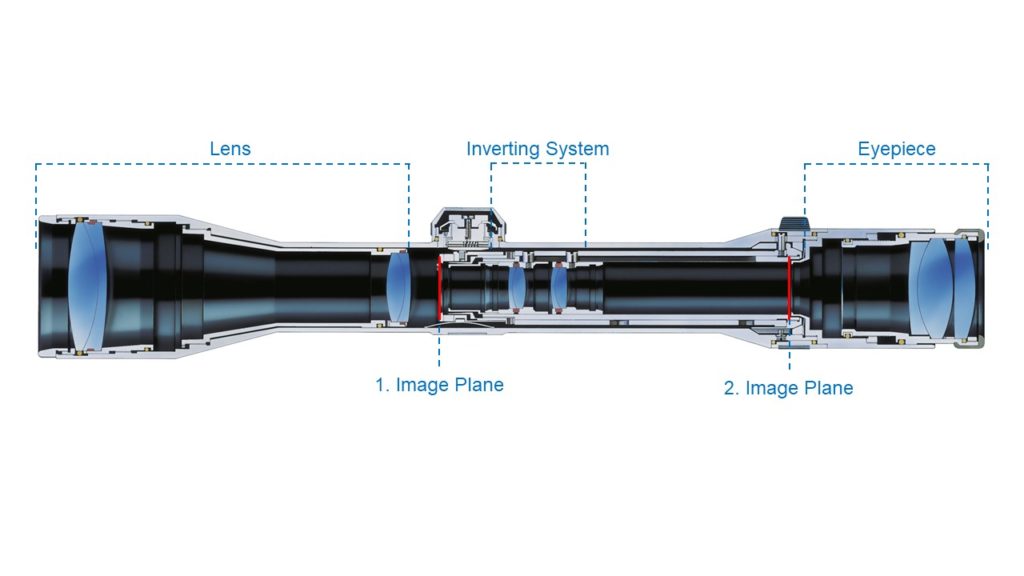
With a few exceptions, the center tube diameter on hunting riflescopes is 30 mm or 1 inch (25.4 mm). The larger diameter offers more room to optimally house the mechanical parts of the zoom system without compromises. Therefore, most 4x zoom scopes include a 30 mm tube, many American 3x zoom scopes a 1 inch tube. With an otherwise identical design, the larger tube, of course, allows larger reticle adjustment ranges and larger fields of view. However, the interrelationships are very complex and often cannot be compared directly. There is no difference regarding brightness and transmission. A thicker tube does not deliver a brighter image – even if this is the prevailing opinion of many users.

Reticles
Every riflescope is equipped with a reticle as a targeting aid. It is selected based on the hunting situation and personal preferences. It is focused for your eyes by means of the diopter setting provided on the eyepiece. Elevation and windage adjustment turrets are used to align the reticle or the sighting line to the bullet’s trajectory precisely.
Types of reticles
Nowadays, illuminated reticles are being used more and more in addition to numerous, traditional reticles such as 4 or 8. With these systems, the light intensity must meet a wide range of different demands: with hunting game at night, there must be a faint glow only without blinding the eye or interfering with the eyes ability to adjust to the dark. On driven hunts, however, bright illumination is required to ensure that the eye can seize the illuminated dot in a fraction of a second in bright daylight. Therefore, the hunting situation is a key factor in the selection of an illuminated reticle. The illumination systems of other ZEISS riflescopes is designed for mere use in low light.

Illuminated
Reticle 20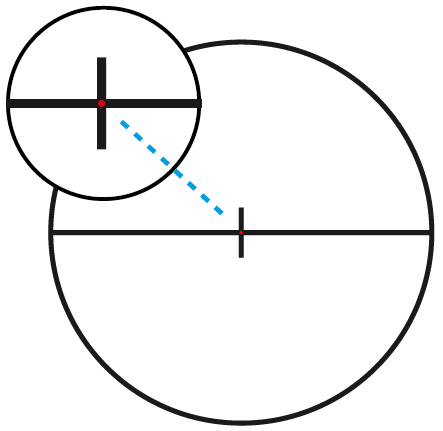
Illuminated
Reticle 54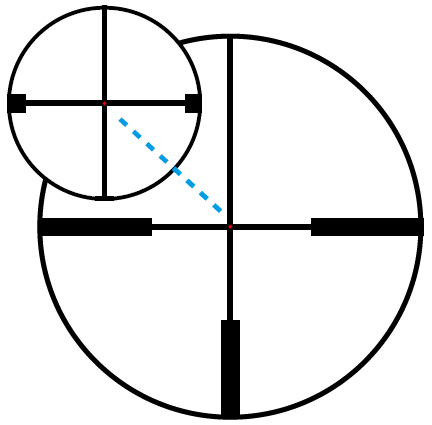
Illuminated
Reticle 60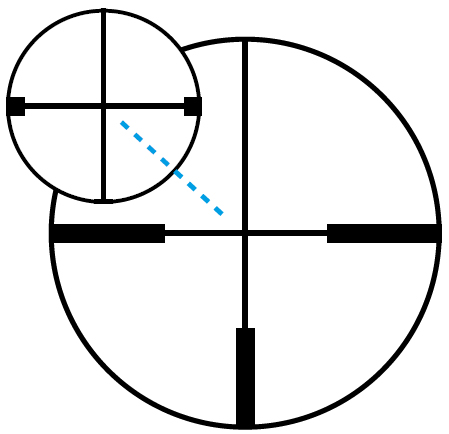
Illuminated
Reticle 6
Reticle planes
The reticle on a riflescope can be positioned in the 1st or 2nd image plane. The difference between the 1st and 2nd image planes appears when the magnification changes or on so-called subtensions.
Subtensions
These describe the size or distance of the reticle in relation to the body of the game, i.e. how much is covered by a line or the illuminated dot at 100m.
Reticles in the first image plane
A reticle in the 1st image plane (in front of the inverting system) changes the same as the actual image does. The reticle and image create a single unit, both increase or decrease in size.
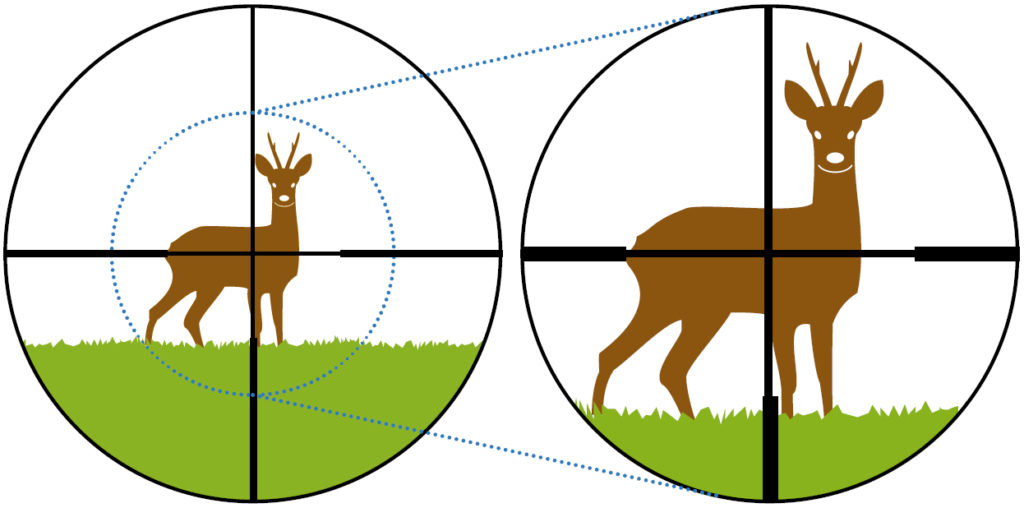
The subtension is therefore the same at all magnification levels so that it is possible to estimate the range easily. For example, if the distance between the horizontal bars on reticle 40 is exactly 70cm at 100m and a deer (typical length of 70 cm) fills half of the intermediate space, it is 200m away regardless of the magnification. An additional property becomes evident in poor light: the bars and lines become wider at higher magnification, making them easier to see. The advantages of the position in the 1st image plane are increasingly disappearing as a result of developments such as an illuminated reticle and laser rangefinders. While earlier, typically “European” riflescopes were equipped with unlit reticles in the 1st image plane; the trend now is towards illuminated reticles in the 2nd image plane.
Reticles in the second image plane
Here, the reticle is behind the zoom inverting system, i.e. in the image plane closer to the eyepiece. When the magnification changes (zoom), it does not affect the reticle which remains constantly fine with minimal target coverage: A key benefit on long-distance shots at high magnification. However, the subtension of the reticles in the 2nd image plane now depends on the magnification setting. The lower the magnification (the smaller the image) the higher the subtension.
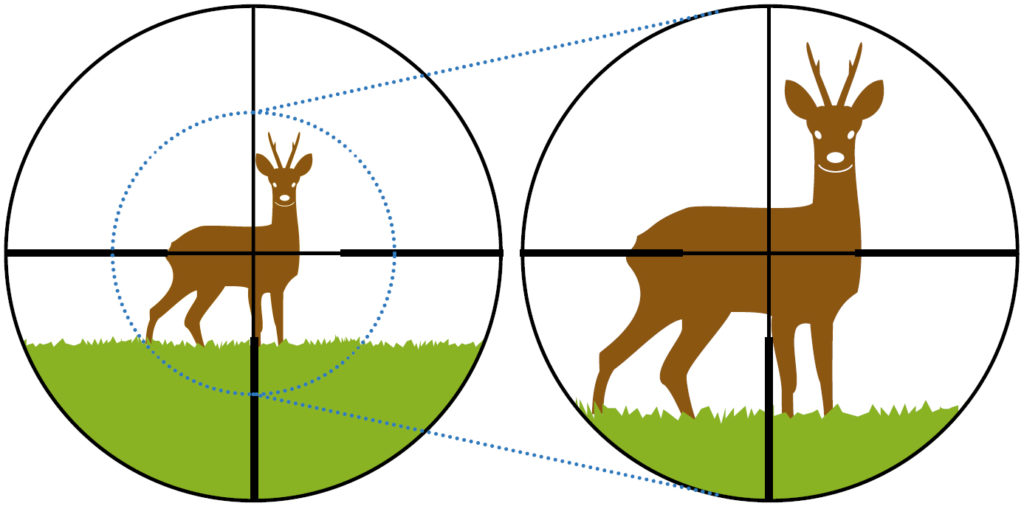
Placing the reticle in the 2nd image plane is more challanging from the technical point of view and more critical than it is in the 1st plane. The moveable parts of the inverting system must be manufactured with extremely narrow tolerances to ensure that the image does not unintentionally move up or down when it is enlarged. Because the reticle is fixed in the second image plane, it would result in considerable deviations in the point of impact in such cases. Thanks to state-of-the-art manufacturing processes with minimal tolerances in production, ZEISS can also deliver maximum reliability here – in all riflescope classes.
Reticle adjustment
The weapon is ranged after the riflescope is mounted. This means that the reticle and sighting line are adjusted to show the exact point of impact of a bullet at a certain distance (e.g. 100 m or GEE). The riflescopes are equipped with elevation adjustment, i.e. two adjustment turrets on the center tube which are used to align the reticle in windage and elevation.
Centered reticles
On older riflescopes, this results in the reticle being positioned somewhere in the image field after ranging instead of in the center. Modern centered reticles avoid this by slightly tipping the entire inverting system so that the entire field of view moves. The reticle is always centered in the image.

Squared reticle adjustment
Most riflescopes include squared reticle adjustment, i.e. there is an equal amount of room for elevation and windage. Special models for longer distances offer an enlarged vertical adjustment range to better compensate bullet drop at long ranges – without compromises for lateral adjustment. On all ZEISS riflescopes it is always ensured that the lateral setting is not influenced when the height is adjusted and vice versa.
Squared reticle adjustment
With each click of the adjustment knobs, the reticles on most “European” models move 1 cm with a target 100 m away, i.e. 1 cm/100m. This is 3cm per click on a 300 m disc. “American” models usually include an adjustment of ¼ MoA = approx. 0.73 cm/ 100m (MoA = minute of angle = 1/60 of a degree).
Zero
After ranging, the adjustment knobs on most riflescopes can be zeroed, i.e. the scale is set to the starting position (zero) without adjusting the reticle. When the reticle is changed again, e.g. to compensate for bullet drop or side wind, the correct position can be restored easily.